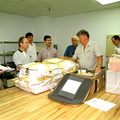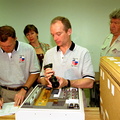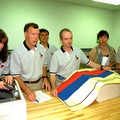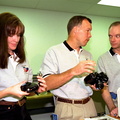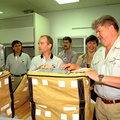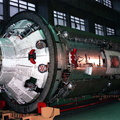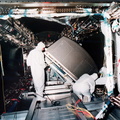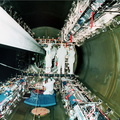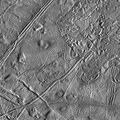
WIKIARCHIVES.SPACE
The Human Spaceflight Archive

Mosaic of Jupiter's northern hemisphere between 10 and 50 degrees latitude. Jupiter's atmospheric circulation is dominated by alternating eastward and westward jets from equatorial to polar latitudes. The direction and speed of these jets in part determine the color and texture of the clouds seen in this mosaic. Also visible are several other common Jovian cloud features, including large white ovals, bright spots, dark spots, interacting vortices, and turbulent chaotic systems. The north-south dimension of each of the two interacting vortices in the upper half of the mosaic is about 3500 kilometers. This mosaic combines the violet (410 nanometers) and near infrared continuum (756 nanometers) filter images to create a mosaic similar to how Jupiter would appear to human eyes. Differences in coloration are due to the composition and abundance of trace chemicals in Jupiter's atmosphere.
Information
- Taken in
- Author
- NASA/JPL-Caltech
- Description
-
Mosaic of Jupiter's northern hemisphere between 10 and 50 degrees latitude. Jupiter's atmospheric circulation is dominated by alternating eastward and westward jets from equatorial to polar latitudes. The direction and speed of these jets in part determine the color and texture of the clouds seen in this mosaic. Also visible are several other common Jovian cloud features, including large white ovals, bright spots, dark spots, interacting vortices, and turbulent chaotic systems. The north-south dimension of each of the two interacting vortices in the upper half of the mosaic is about 3500 kilometers. This mosaic combines the violet (410 nanometers) and near infrared continuum (756 nanometers) filter images to create a mosaic similar to how Jupiter would appear to human eyes. Differences in coloration are due to the composition and abundance of trace chemicals in Jupiter's atmosphere.
North is at the top. The images are projected on a sphere, with features being foreshortened towards the north. The smallest resolved features are tens of kilometers in size. These images were taken on April 3, 1997, at a range of 1.4 million kilometers by the Solid State Imaging system (CCD) on NASA's Galileo spacecraft.
The Jet Propulsion Laboratory, Pasadena, CA manages the mission for NASA's Office of Space Science, Washington, DC.
- Created on
- Thursday 26 March 1998
- Albums
- US SPACE PROGRAM / PROBES / JUPITER / GALILEO / Mission Photos (Edited) / JUPITER
- Source link
- https://photojournal.jpl.nasa.gov
- Visits
- 14
- Rating score
- no rate
- Rate this photo
- License
- Public Domain
- Modified by WikiArchives
- No (original)
- Downloads
- 1
Powered by Piwigo
